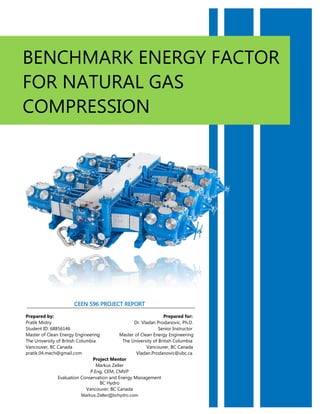
Capstone Project Report Summary
- 1. BENCHMARK ENERGY FACTOR FOR NATURAL GAS COMPRESSION CEEN 596 PROJECT REPORT Prepared by: Prepared for: Pratik Mistry Dr. Vladan Prodanovic, Ph.D. Student ID: 68856146 Senior Instructor Master of Clean Energy Engineering Master of Clean Energy Engineering The University of British Columbia The University of British Columbia Vancouver, BC Canada Vancouver, BC Canada pratik.04.mech@gmail.com Vladan.Prodanovic@ubc.ca Project Mentor Markus Zeller P.Eng, CEM, CMVP Evaluation Conservation and Energy Management BC Hydro Vancouver, BC Canada Markus.Zeller@bchydro.com
- 2. I Executive summary: This study was carried out as a capstone project for Masters of Clean Energy Engineering course at the University of British Columbia from Jan-2016 to April-2016. BC Hydro – Power smart engaged with UBC to undertake a study into the monitoring and energy performance measurements for natural gas compressor systems. The objective of the study was to develop an Excel based standard model on energy performance of natural gas compressors for the determination of the controllable and non-controllable energy associated with natural gas compression process. This report focuses solely on an electric motor driven reciprocating compressors which are installed in the upstream of oil & gas (UOG) industry. The Benchmark Energy Factor (BEF) criterion was used to determine the energy performance of the compressor. The BEF, actual energy consumption divided by essential energy consumption, allows for a comparison of energy performance by taking into account the energy consumption of any industrial process in relation to the varying input & output material over time. Primary data collection was targeted from BC Oil & Gas commission (BCOGC) & Ministry of Natural Gas Development (MNGD). The data collection target was established for all electric driven compressors installed in UOG sector of British Columbia but due to complexity and large uncertainties of online data, this target was not completely achieved. In order to complete the project within the timeline, a site visit was therefore arranged with a total of 6 natural gas processing plants where electric driven
- 3. II compressors are installed. The visited plants provided an appropriate instantaneous data for the calculation of the BEF. Key findings of the study include: • The calculated values of instantaneous BEF for 5 different natural gas processing plants that can be used to support the implementation of natural gas compression process-based benchmarking at the entire UOG industry sector. The calculated BEF values are not as robust as it should be but represent acceptable values that can be used to compare the energy performance of the compressors within the plant and across the plant. In real-world application, benchmarking requires great effort for large historic data collection to design a reasonably accurate baseline energy model for all scenarios. However, at the entire UOG sector level, calculations should be treated with caution and further in-depth analysis is required to meet the goal of this project. • The benchmarking of natural gas compression system’s energy use can provide valuable insights regarding energy efficiency potentials at UOG industry sector.
- 4. III Table of Contents Acknowledgements:..................................................................................................................................... Executive summary:.....................................................................................................................................I List of figures..............................................................................................................................................IV List of tables ...............................................................................................................................................IV List of Abbreviations:.................................................................................................................................... Introduction:................................................................................................................................................1 1. Project Work:......................................................................................................................................... 1.1 Area and scope of the project:...................................................................................................... 1.2 Background work: ........................................................................................................................... 1.3 Purpose:............................................................................................................................................ 1.4 Objective: ......................................................................................................................................... 1.5 Adiabatic horsepower approach................................................................................................... 1.6 Data sources: ................................................................................................................................... 2. Site Visit:................................................................................................................................................. 2.1 Plant visit photos:............................................................................................................................. 2.2 Site visit data collection:................................................................................................................. 3. Calculation: ............................................................................................................................................ 3.1. Instantaneous Benchmark Energy Factor (BEF): ............................................................................ 3.2. Compressor theoretical power (Pt): ................................................................................................ 3.3. Natural Gas compressibility factor (Z): ........................................................................................... 3.4. Adiabatic exponent (k):..................................................................................................................... 3.5. Discharge temperature (T2): ............................................................................................................ 3.6. Adiabatic efficiency (Ƞa):................................................................................................................... 3.7. Gas flow rate (Q):............................................................................................................................... 3.8. Results: ................................................................................................................................................ 4. Conclusion: ............................................................................................................................................ 4.1. Recommendations for future work: ................................................................................................ 4.2. Barriers: ............................................................................................................................................... References: .................................................................................................................................................... Appendix A: ...................................................................................................................................................
- 5. IV List of figures Figure 1 : Natural Gas Transportation Process ......................................................................................... Figure 2 : Generalization of an Industrial Process.................................................................................... Figure 3 : Daily energy consumption trend of five different natural gas compressor stations.......... Figure 4 : Daily Observed Specific Energy Consumption Trend (kWh/E3m3)...................................... Figure 5 : Compression curve...................................................................................................................... Figure 6 : Natural Gas Gathering Pipeline System ................................................................................... Figure 7 : Natural Gas Wellhead................................................................................................................. Figure 8 : Natural gas gathering pipeline entering the processing plant............................................. Figure 9 : One of the natural gas processing plants................................................................................ Figure 10 : 2-stage 6-cylinder Ariel KBZ reciprocating compressor model.......................................... Figure 11 : Historic Benchmark Energy Factor for reciprocating compressor (Ariel JGZ/4) ............... List of tables Table 1 : Basic details of the plants visited................................................................................................ Table 2 : Calculated values of Instantaneous Benchmark Energy Factor..............................................
- 6. 1 Introduction: Today’s increased world population has raised tremendous energy demand. Natural gas being superior to other energy sources in economic attractiveness and environmental concern will remain the preferred fuel to meet this ever growing energy demand in the future. At the upstream processing steps, the natural gas compression process is one of the major energy consuming processes. Process-based energy benchmarking which is very helpful for identifying the potential for improving energy performance effectively can be designed and implemented for this natural gas compression process. As an effective energy analysis tool, benchmarking has been used in many areas for different objectives. Following the scope of this project, this report presents its contents in four different sections. 1) Project work: It contains background information, area focused, main purpose and objective, approach and methodology chosen for this project. 2) Site visit: It contains the details on natural gas processing plant visited for this project. 3) Calculation: It provides how calculations were carried out to get the results for this project. 4) Conclusion: This section contains a brief conclusion of the project work and provides some recommendations to take this project ahead. It also includes the barriers to be considered in the future for successful implementation of this project. Note: Kindly contact for the whole report!